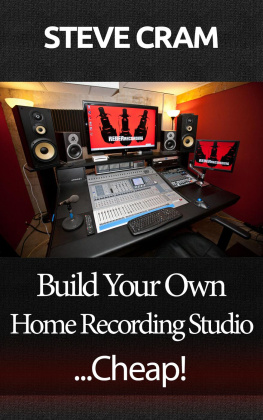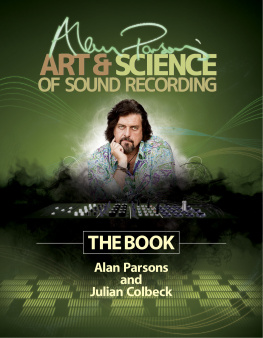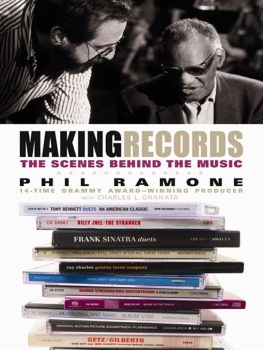PICTURE CREDITS The photographs reproduced in this book and on the jacket are almost all from Michael Ochs Archives/Redferns, except: p.22/23 Frank Laico; p.152/153 New Eyes/Redferns; and p.164/165 Photos By PoPsie 2004 Michael Randolph.
THE AUTHOR would like to thank the following for their participation and patience: Brooks Arthur; Randy Bachman; Tony Bennett; Hal Blaine; Artie Butler; Alice Cooper; Jason Corsaro; Marshall Crenshaw; Dennis Diken; John Einarson; Matthew Goldman; Lou Gonzalez; Al Gorgoni; Roy Halee; Jerry Harrison; Chris Huston; Janis Ian; Jimmy Johnson; George Klabin; Al Kooper; Frank Laico; Gene Lees; Jeffrey Lesser; Peter Lewis; Sherry Lookofsky; James Lowe; Bob Ludwig; Richard Lush; Arif Mardin; Robert Margouleff; Elliot Mazer; Mitch Miller; Don Puluse; Phil Ramone; Jim Reeves; Mike Rosenberg; Stan Ross; David Rubinson; Todd Rundgren; Walter Sear; Ed Stasium; Stephen Stills; Gordon Stoker; Joe Tarsia; Creed Taylor; Ken Townsend; Matt Wallace; Jerry Wexler; and Zal Yanovsky (the late great).
SOURCES The vast majority of quotes in this book are from interviews by the author, with the following exceptions. Jerry Wexler describing Tom Dowd comes from Wexlers autobiography with David Ritz, Rhythm and the Blues (Random House 1993). The Dowd quotes not attributed to Blair Jackson are from the documentary The Language of Music. The Shadow Morton quote in reference to Artie Butler comes from a Goldmine interview by Richard Arfin published in 1991. The John Simon quote is from an interview with Lee Gabites at http://theband.hiof.no/articles/the_truth.html. The
Shelly Yakus quotes are from a ProSoundWeb online article by Bruce Borgerson at www.prosoundweb.com/recording/bruce_borgeson/shelly/shelly.shtml. And the Milt Gabler quote about the Pythian Temple is from Ted Foxs In the Groove (St Martins 1986).
OTHER MATERIALS absorbed during research include a number of books: Girl Groups: The Story of a Sound by Alan Betrock (Bookthrift 1985); The Beatles: Recording Sessions by Mark Lewisohn (Harmony 1990); For What Its Worth: The Story of Buffalo Springfield by John Einarson & Richie Furay (Cooper Square 2004); Shakey: Neil Youngs Biography by Jimmy McDonough (Random House 2002); and Kind of Blue: The Making of the Miles Davis Masterpiece by Ashley Kahn & Jimmy Cobb (Da Capo 2001). Some TV/film documentaries: the A&E Biography program Brian Wilson; Tom Dowd & the Language of Music; Hitmakers: The Teens Who Stole Pop Music; and Inside Pop: The Rock Revolution. Some periodicals: Home Recording Magazine; Mix Magazine; and Goldmine magazine. And a couple of prime websites: Spectropop.com; and ProSoundWeb.com.
THE PUBLISHER would like to thank: Paul Cooper; Kim Devlin; John Morrish; and Julian Ridgway.
Making records used to be like painting. Then it turned into assembling.
Frank Laico.
DAVID SIMONS has written extensively about the recording arts, past present, for Musician. Home Recording, Guitar One, Acoustic Guitar , and other publications. He maintains a basement studio at his New England home, complete with live echo chamber and an arsenal of aging equipment.
new york recording now and then
Miles Davis at Columbias 30th Street studio, recording Kind of Blue , March 1959.
T he bright red awnings of Maxies Delicatessen add color to the otherwise drab exterior of 723 7th Avenue, an ancient 12-story structure that has played a part in creating some of the most popular sounds made in the city of New York.
Since 1978, the building, at the corner of West 48th Street, has been home to Quad Recording Studios, owned by veteran engineer Lou Gonzalez. Its client list includes modern hitmakers like Alicia Keys, Destinys Child and Coldplay. Quads predecessor, Associated Sound, was a favorite hangout for 1960s songwriters like Barry Mann and Cynthia Weil, and the birthplace of My Boyfriends Back and other hits of the girl-group era.
The interior of 723 7th is remarkably well preserved. Riding up the old-style elevator, one can easily imagine producer Jeff Barry on his way to a sixth-floor session. or Carole King heading back to her Broadway cubicle to finish off Hey Girl with husband Gerry Goffin.
Gonzalez, who got his start turning the dials at Bob Goldmans Mira Sound Studios in the late 1960s, has never completely shed his sense of tradition: a fleet of Studer tape machines and other relics of the past has been seamlessly integrated into each of Quads state-of-the-art recording rooms. Still, Quads beautifully appointed studios are a reminder of just how much the business of making music has changed over the years. Sleek, automated consoles have long since replaced the funky old mixing desks of yesteryear. Where artists once labored to get the job done in two hours using three tracks, Quads visitors are afforded a virtually endless supply of work space.
The same technology that transformed full-service studios like Quad over the past decade also lit a fire under the home-studio market. Today, even the most basic do-it-yourself machine offers at least eight recording tracks (four more than the Beatles had) and an array of built-in effects, giving musicians the freedom to work on new ideas on the spot rather than wait to book studio time or assemble a crew of players, Its impact on the record industry has been considerable.
Nearly one-third of the hits Ive done have originated in the home or home-type studio, notes Dave Hard Drive Pensado, who helped deliver Pinks 2001 classic M!ssundaztood album.
In many ways there are a lot of things the home guys do that are in fact better than the recordings that come from a big facility. Thats because, in general, the creativity that emerges from a home studio almost always surpasses that of an expensive studio. Never mind the sound quality personally, Id rather start with the kind of feeling and emotion you get on a homemade record like Pinks. Thats the main thing.
For those who believe that an Internet-based musical revolution is at hand, the prospect of a 16-track in every garage is certainly good news. But theres a flip side to all this digital democracy. As sophisticated machinery like ProTools becomes more affordable, even professional artists are now minimizing their trips to the studio. The increasingly popular practice of shuttling tracks back and forth between living room and control room means that, now more than ever, records are being produced bit by bit, rather than in one large gulp, as was once the norm. Great for the bottom line, perhaps - but not always the best thing for the listener.
When you have excellent players all working together at once, there is usually some friendly competition. People tend to perform to the best of their abilities, notes Matt Wallace, producer for Maroon 5. Faith No More and Paul Westerberg. The interaction sparks additional excitement, thereby creating a more lively track. It plays a large part in the overall warmth and spirit of the recording. Thats whats at stake when you go it alone.
Moreover, the ability to fine-tune every element ol the recorded work combined with the more leisurely approach to recording that is itself a byproduct of the digital age has all but removed the chance for anything haphazard or accidental from sneaking onto the finished product.
People now have the wherewithal to make really perfect-sounding records. says Wallace. But from my experience, as the quality of the recording gets better, the quality of the musicianship very often suffers. The result is a safer, homogenized product. Josh Freese, a top session drummer who has worked for Evanescence, Avril Lavigne and the Offspring adds, Lets face it when youve got Pro Tools, theres no need for those pesky chops.













